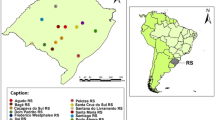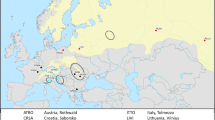Abstract
The fungus gnat, Bradysia difformis (Sciaridae: Diptera) has recently been recorded for the first time from South Africa where it has been found in forestry nurseries. The presence of this insect in all the major forestry nurseries as the dominant and only sciarid species raises intriguing questions regarding its origin and population genetic structure. A 395 bp portion of the mitochondrial COI gene was analysed from B. difformis individuals collected from four nursery populations in South Africa and three nursery populations in Europe. Shared haplotypes between South African and European populations indicated a historical connection. South African populations showed high genetic diversity and low genetic differentiation. These patterns most likely reflect multiple and/or relatively large introductions of B. difformis into South Africa from its origin combined with subsequent and continued movement of plants between nurseries.
Similar content being viewed by others
References
Altschul SF, Madden TL, Schäffer AA, Zhang J, Zhang Z, Miller W, Lipman DJ (1997) Gapped BLAST and PSI-BLAST: a new generation of protein database search programs. Nucleic Acids Res 25:3389–3402. doi:10.1093/nar/25.17.3389
Clement M, Posada D, Crandall KA (2000) TCS: a computer program to estimate gene genealogies. Mol Ecol 9:1657–1660. doi:10.1046/j.1365-294x.2000.01020.x
Excoffier L, Laval LG, Schneider S (2005) Arlequin ver 3.0: an integrated software package for population genetics data analysis. Evol Bioinform Online 1:47–50
Hellqvist S (1994) Biology of Synacra sp. (Hym., Diapriidae), a parasitoid of Bradysia paupera (Dipt., Sciaridae) in Swedish greenhouses. J Appl Entomol 117:491–497
Hungerford HB (1916) Sciara maggots injurious to potted plants. J Econ Entomol 9:538–553
Hurley BP, Govender P, Coutinho TA, Wingfield BD, Wingfield MJ (2007) Fungus gnats and other Diptera in South African forestry nurseries and their possible association with the pitch canker fungus. S Afr J Sci 103:43–46
Menzel F, Smith JE, Colauto NB (2003) Bradysia difformis Frey and Bradysia ocellaris (Comstock): two additional neotropical species of black fungus gnats (Diptera: Sciaridae) of economic importance: a redescription and review. Ann Entomol Soc Am 96:448–457. doi:10.1603/0013-8746(2003)096[0448:BDFABO]2.0.CO;2
Rozas J, Sanchez-DelBarrio JC, Messeguer X, Rozas R (2003) DnaSP, DNA polymorphism analysis by the coalescent and other methods. Bioinformatics 19:2496–2497. doi:10.1093/bioinformatics/btg359
Simon C, Frati F, Beckenbach A, Crespi B, Liu H, Flook P (1994) Evolution, weighting, and phylogenetic utility of mitochondrial gene sequences and a compilation of conserved polymerase chain reaction primers. Ann Entomol Soc Am 87:651–701
Thompson JD, Gibson TJ, Plewniak F, Jeanmougin F, Higgins DG (1997) The ClustalX windows interface: flexible strategies for multiple sequence alignment aided by quality analysis tools. Nucleic Acids Res 24:4876–4882. doi:10.1093/nar/25.24.4876
Viljoen A, Wingfield MJ, Marasas WFO (1994) First report of Fusarium subglutinans f. sp. pini on pine seedlings in South Africa. Plant Dis 78:309–312
White PF, Smith JE, Menzel F (2000) Distribution of Sciaridae (Dipt.) species infesting commercial mushroom farms in Britain. Entomologists Mon Mag 136:207–209
Wingfield MJ, Hammerbacher A, Ganley RJ, Steenkamp ET, Gordon TR, Wingfield BD, Coutinho TA (2008) Pitch canker caused by Fusarium circinatum—a growing threat to pine plantations and forests worldwide. Plant Pathol 51:397. doi:10.1046/j.1365-3059.2002.00710.x
Acknowledgments
We thank the members of the Tree Protection Cooperative Programme (TPCP), for their assistance in this study. We also thank the Department of Forest Mycology and Pathology, Swedish University of Agricultural Sciences, Uppsala, Sweden, for the use of their facilities and Dr. Lea Milevoj (University of Ljubljana) for providing specimens from Slovenia. The National Research Foundation (NRF), members of the TPCP and the THRIP initiative of the Department of Trade and Industry (DTI), South Africa are recognised for financial support.
Author information
Authors and Affiliations
Corresponding author
Rights and permissions
About this article
Cite this article
Hurley, B.P., Slippers, B., Wingfield, B.D. et al. Genetic diversity of Bradysia difformis (Sciaridae: Diptera) populations reflects movement of an invasive insect between forestry nurseries. Biol Invasions 12, 729–733 (2010). https://doi.org/10.1007/s10530-009-9509-1
Received:
Accepted:
Published:
Issue Date:
DOI: https://doi.org/10.1007/s10530-009-9509-1




